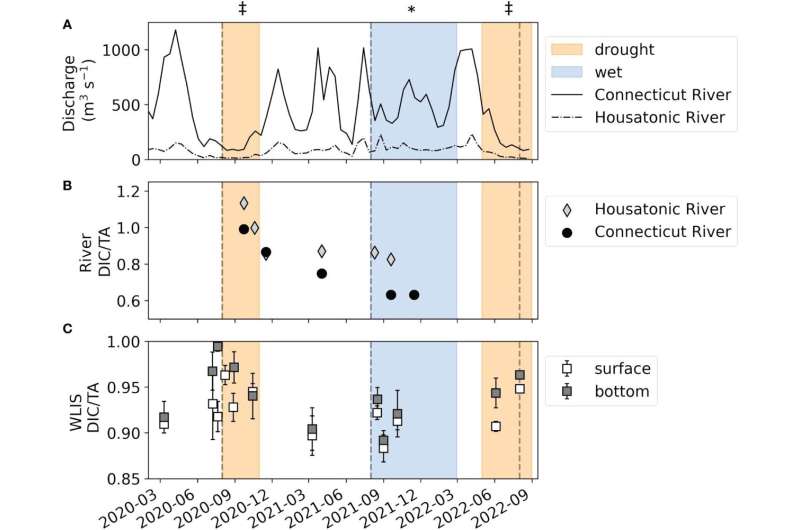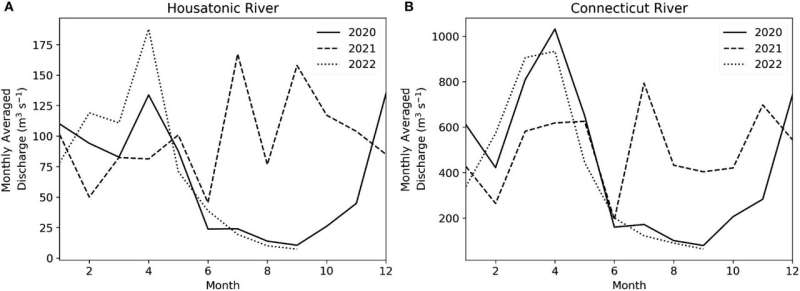
New York’s Long Island Sound (LIS) is an important inlet and estuary in the North Atlantic Ocean, which is highly urbanized due to its proximity to the city. This daily activity of passenger transport, fishing and cargo ships has had significant consequences on the marine landscape here, resulting in environmental degradation that impacts the flora and fauna that call LIS home.
Beyond noise pollution from the heavy water traffic, chemical and nutrient pollution has led to eutrophication, where enrichment of surface waters enhances primary productivity and causes algal blooms to proliferate.
Microbial metabolism of these algae as they die uses up large amounts of oxygen, thus reducing the amount of dissolved oxygen through the lower water column for other consumers. The resultant bottom water hypoxia can prove challenging for the survival of all other organisms living below the surface and leads to mass die-off, something that has particularly been seen with fish.
Eutrophication has also been linked to acidification of the ambient waters, and is the focus of new research published in Frontiers in Marine Science. Doctoral Researcher Lauren Barrett, of the University of Connecticut, and colleagues investigated the impact of eutrophication-induced acidification on the marine carbonate system of LIS. Here, the nutrient-enrichment is mostly nitrogen derived from atmospheric deposition, wastewater discharge and fertilizer runoff.
To explore this, the researchers sampled the western LIS multiple times between 2020 and 2022 to capture seasonal and annual changes in measurements of dissolved organic carbon and total alkalinity. It is important to measure these two parameters, as pH alone is insufficient to fully define changes in the ocean carbonate system. The studied timeframe also permits comparison to 2021, which experienced higher freshwater input to LIS due to tropical storms, and the bounding years of 2020 and 2022, during which droughts prevailed.

Initial measurements of monthly discharge indicate the hydrological patterns of the tributary inputs to LIS, with the Houstatonic River to the center/west and the Connecticut River to the east accounting for 10% and 75% of the total freshwater flow into LIS respectively. In 2021, discharge was 3–4 times greater than for the droughts in August–September of 2020 and 2022, highlighting the impact of four local tropical storms between July and September on the rivers and LIS.
Barrett and the team identified elevated total alkalinity at the estuary mouth, decreasing westwards towards the estuary head, and peaking during August to October. Meanwhile, dissolved organic carbon increased with depth and proximity to the estuary mouth. During the summer months, the stratification of LIS generated a large gradient in dissolved organic carbon through the water column, with a reduction at the surface due to primary productivity, but an increase at depth in subsurface metabolism of organic matter.
Overall, the researchers noted reduced acidification in the western LIS during 2021, corresponding to lower dissolved organic carbon and total alkalinity via the input flow of the Housatonic River. Conversely, during the drought seasons, dissolved organic carbon and total alkalinity increased through the river discharge to the estuary, resulting in acidifying conditions in LIS.
Therefore, there is a strong link between hypoxia and acidification resulting from eutrophication, particularly during seasons of low river flow. This is the opposite pattern to other estuaries that see reduced nutrient input during low-flow seasons and therefore a decline in hypoxia and eutrophication during droughts.
While efforts have been made to reduce the amount of nitrogen reaching LIS, with implementation of nitrogen total maximum daily loads in 2000 leading to a 58.5% reduction in nitrogen input by 2016, further eutrophication mitigation measures are required to reduce hypoxia and acidification of this important marine environment. As droughts are predicted to worsen in the future as climate change continues, acidification of LIS could become an ever more pressing issue.
More information:
Lauren J. Barrett et al, Droughts and deluges: changes in river discharge and the carbonate chemistry of an urbanized temperate estuary, Frontiers in Marine Science (2024). DOI: 10.3389/fmars.2024.1398087
© 2024 Science X Network
Citation:
New York’s Long Island Sound acidifies during droughts (2024, July 30)
retrieved 30 July 2024
from https://phys.org/news/2024-07-york-island-acidifies-droughts.html
This document is subject to copyright. Apart from any fair dealing for the purpose of private study or research, no
part may be reproduced without the written permission. The content is provided for information purposes only.
